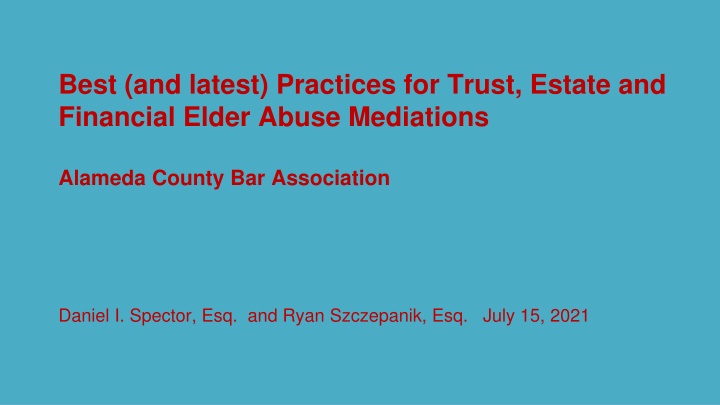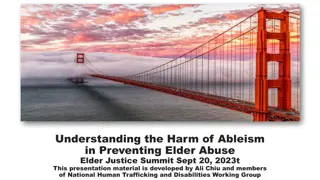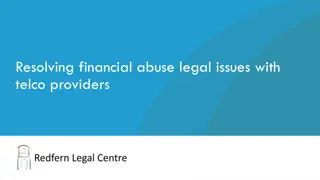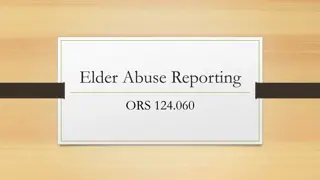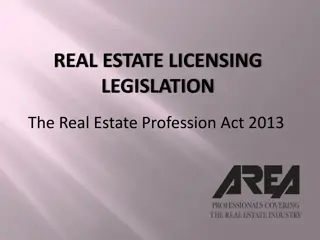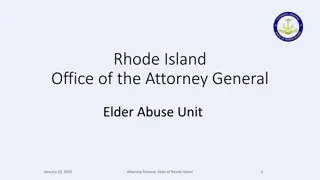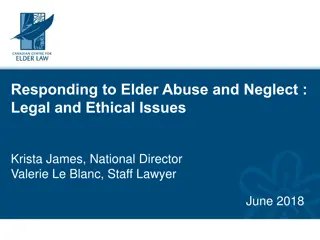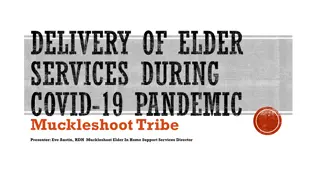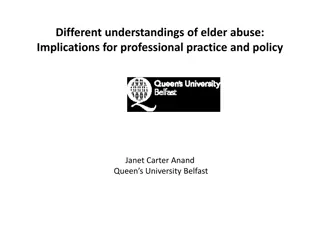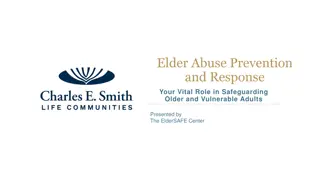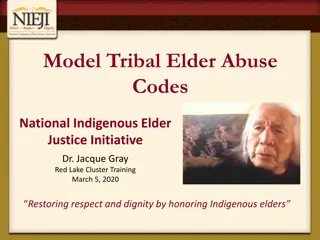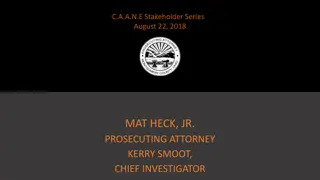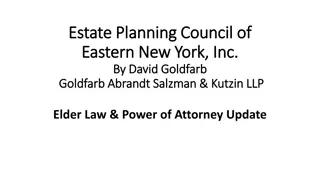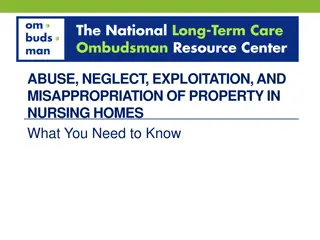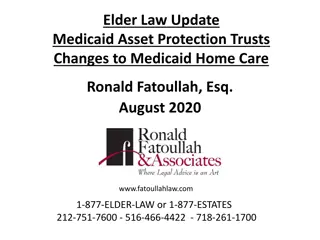Best Practices for Trust, Estate, and Financial Elder Abuse Mediations
This article discusses the common methods of resolution and unique characteristics of Trust, Estate, and Financial Elder Abuse (T&E, FEA) mediations, emphasizing emotional and legal contexts. It also highlights the right time to participate in T&E, FEA mediation, stressing the importance of understanding strengths, weaknesses, and risks. The insights provided aim to enhance the effectiveness of mediations in Alameda County. In-depth analysis and practical suggestions make this a valuable resource for legal professionals.
Download Presentation

Please find below an Image/Link to download the presentation.
The content on the website is provided AS IS for your information and personal use only. It may not be sold, licensed, or shared on other websites without obtaining consent from the author.If you encounter any issues during the download, it is possible that the publisher has removed the file from their server.
You are allowed to download the files provided on this website for personal or commercial use, subject to the condition that they are used lawfully. All files are the property of their respective owners.
The content on the website is provided AS IS for your information and personal use only. It may not be sold, licensed, or shared on other websites without obtaining consent from the author.
E N D
Presentation Transcript
Best (and latest) Practices for Trust, Estate and Financial Elder Abuse Mediations Alameda County Bar Association Daniel I. Spector, Esq. and Ryan Szczepanik, Esq. July 15, 2021
Common Methods of Resolution * at any time, very low level of client participation in resolution, seldom results in resolution); Direct, two-party negotiations between counsel (procedurally inefficient, may occur Mandatory Settlement Conference (can be efficient, occurs after substantial financial investment in trial has occurred, low to moderate level of client participation, about 50% chance of resolution); and Mediation (procedurally efficient, high level of client participation, high degree of success).
Unique Characteristics of T&E, FEA MediationsEmotional Context * Parties usually related and/or known to each other; * Allegations reflect a violation of parties relationship and violation of the memory of the decedent/vulnerable person; With FEA, victim usually someone from older generation than parties, may have been peacemaker, role-model; and * Usually someone has died, and the litigants would normally be grieving, but instead they are fighting impact. *
Unique Characteristics of T &E, FEA MediationsLegal Context: Trust contest, 17200 questions (interpretations, characterization of assets) Probate division, tax implications, attorneys fees; 859/259 Claim Probate division, attorneys fees, bad faith; Claims against fiduciary: Removal, suspension, temp. special, types of breach, remedies for breach, impact of exculpatory clauses (shifting bop, attorneys fees); Straight Claim for FEA general civil division/jury trial, attorneys fees and differing bop; Grounds for suspension/removal 15642, attorneys fees; and Claims involving contested conservatorships, attorneys fees;
When Is the Time Right to Participate In a T&E, FEA Mediation? Short Answer: when the parties and counsel understand the strengths, weaknesses and risks of their respective positions. Usually, pleadings settled, medical (including caregiving), financial and legal records obtained, state planner s deposition taken (if case involves estate planning document) or financial advisor/banker s deposition taken (if financial account/designation change), and parties depositions have been taken. Can the FEA mediation occur before this? Of course but the less information obtained usually means the more each party is anchored to their own perspectives based on family history, dark suspicion and the unknown. Breslin v. Breslin (2021) B301382 (Second Dist.) the court may order the parties to attend mediation and enforce a settlement agreement upon duly noticed parties who chose not to attend mediation. Order for mediation, Notice to Parties?
Questions for Counsel To Select the Right Mediator A. complex emotions, differing perspectives and legal issues involving and T&E, FEA mediation? An effective mediator is not an adjudicant; rather, the best mediator is practiced in the art of handling all sides of an argument. Does the mediator have the qualifications and experience to organize and guide a process involving the B. able to vary his/her style to fit the client s and counsel s needs?; Every case varies does the mediator have a particular mediating style, and is the mediator wiling and C. Mediator have access to the right tools of the trade. 1) Separate, sound proof rooms; 2) Parking; 3) Reliable wi-fi; and 4) Virtual Capacities (use of Zoom or similar, secure platform, command and use of shared files and Docusign). D. participate for the full day and into the evening at a time when the case is ready to be mediated and not too late thereafter. Mediator/Counsel/Parties Availability: Find a date when everyone can be physically present or otherwise
Pre-Mediation Tasks for Counsel A. Reach agreement with opposing counsel regarding allocation of mediation cost (and if necessary involve mediator); B. Explaining to client the nature, process of mediation, why mediation in client s interests, and elusive road to justice at trial; C. Explanation of specific processes generally used by particular mediator; D. Discussion of roles of client, counsel, mediator, support persons, potential witnesses and use of evidence; E. Discussion of who speaks and control of communications during negotiations; F. Confidentiality disclosure (Ev. Code Section 1129); G. Overview of factual and legal strengths and weaknesses (can you explain to your client case is weak and/or they are a danger to their own case without being fired?); H. Setting Expectations: risk assessment and a range of reasonableness; I. From the mediator s perspective: answer to the question: who will draft the settlement agreement and can we at least circulate the recitals in advance of the mediation? J. Breslin Order, Notice of Mediation.
The Mediation Brief A. The purpose of the brief varies depending on your audience; B. Brevity is your friend; C. Attachments: yes, no and to what regard? D. Stating negotiating positions in the mediation brief; E. To exchange or not to exchange (and is there a middle ground)? F. From the mediator s perspective: if the briefs reflect substantial disagreements regarding the law or facts, we will likely have a pre-mediation call with practitioners to make sure, at the least, they each understand their own risk-assessments.
Behavior/Presentation at a T&E, FEA Mediation A. Timeliness; B. Appropriate dress and jewelry; C. Behavior during joint session; D. Avoiding props (such as photos of the deceased/victim); E. Listening to question/answering the question, allowing each person to speak w/out interruption (if no deposition, allowing parties to tell their stories and feeling heard); F. Coaching parties and counsel on listening to the information for understanding, not for making counter-points; G. Identifying each party s needs/goals from the resolution of the case, working together to meet differing needs; H. Hydration/Food intake; I. Negotiations (point of contact, poker faces, working as a team and making your best deal); J. Mediator s Perspective: I am trying to expand the definition of team to include all sides to work together to find collective wins; and K. Note-taking of the deal points.
The Mediation Settlement Agreement in T&E, FEA Resolutions Yes, yes, a thousand times yes! If so, when (at mediation vs. later); The need for a separate 664.6 Stipulation and Order signed by the parties in T&E cases; Uniform Electronic Transactions Act (CC 1633.1 et seq.), DocuSign and the intention to be bound by an electronic signature; Inclusion of CC 1542 Release; Confidential settlement agreements are disfavored in civil financial abuse claim. (CCP 2017.310.); Explaining the provisions of a Settlement Agreement to your client; Who should sign agreement (attorneys?) Who holds the original Settlement Agreement?
Limitations Unique to FEA Claims: Civil elder abuse settlement agreements may NOT include: A provision that prohibits any party to the dispute from contacting or cooperating with APS, local law enforcement, long-term care ombudsman, DOJ and other various governmental agencies, a licensing or regulatory agency that has jurisdiction over the license or certification of the defendant, a protection and advocacy agency; or defendant's current employer if the defendant's job responsibilities include contact with elders, dependent adults, or children, provided that the party contacting or cooperating with one of these entities had a good faith belief that the information he or she provided is relevant to the concerns, duties, or obligations of that entity. A provision that prohibits any party to the dispute from filing a complaint with, or reporting any violation of law to, the same agencies listed previously. A provision that requires any party to the dispute to withdraw a complaint he or she has filed with, or a violation he or she has reported to, the same agencies listed previously. (Welf. & Inst. Code, 15657.8(a).)
FEA Settlement Agreements, Cont Malpractice claims are generally not assignable in California.
Court Approval Needed for T&E, FEA Mediated Settlements? Court Approval of Settlement Agreement? A. If no pending action, Stipulation for Confession of Judgment or Confession of Judgment Clause; B. Assuming pending action: Probate Court vs. General Civil; C. Stipulation v. Petitions for Approval/Breslin Petition; and D. Opposition to Petition for Approval, and what happens?
Effectuation of the Settlement Agreement A. Compliance with terms; B. Non-compliance: return to the mediator, arbitration, and/or seeking judgment to enforce; and C. Dismissal of all claims with Prejudice and Notice of Entry of Dismissal.
